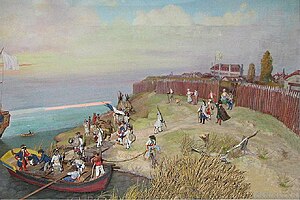Fort Niagara
|
Colonial Niagara
|
|

View of French Castle at Fort Niagara
|
|
| Location | Fort Niagara State Park, Porter, Niagara County, New York, USA |
|---|---|
| Nearest city | Youngstown, New York |
| Coordinates | 43°15′46″N 79°03′47″W / 43.26278°N 79.06306°WCoordinates: 43°15′46″N 79°03′47″W / 43.26278°N 79.06306°W |
| Area | 250 acres (100 ha) |
| Built | 1726 |
| NRHP Reference # | 66000556 |
| Significant dates | |
| Added to NRHP | October 15, 1966 |
| Designated NHL | October 9, 1960 |
| Fort Niagara | |
|---|---|
| Youngstown, New York | |

Fort Niagara 1728
|
|
| Type | Trading Post |
| Site information | |
| Controlled by |
New France 1678–1759 Great Britain 1759–1796 U.S. Army 1815–1963 U.S. Coast Guard 1963–present |
| Site history | |
| Built | 1678 |
| In use | 1726–present |
| Battles/wars | War of 1812 |
| Garrison information | |
| Past commanders |
John W. Heavey (1916–1917) |
Fort Niagara is a fortification originally built to protect the interests of New France in North America. It is located near Youngstown, New York, on the eastern bank of the Niagara River at its mouth, on Lake Ontario.
René-Robert Cavelier, Sieur de La Salle built the first structure, called Fort Conti, in 1678. In 1687, the Governor of New France, the Marquis de Denonville, constructed a new fort at the former site of Fort Conti. He named it Fort Denonville and posted a hundred men under the command of Capt. Pierre de Troyes, Chevalier de Troyes. The winter weather and disease was severe, and all but twelve perished by the time a relief force returned from Montreal. It was decided in September 1688 to abandon the post and the stockade was pulled down. In 1726, a two story "Maison a Machicoulis" or "Machicolated House" was constructed on the same site by French engineer Gaspard-Joseph Chaussegros de Léry. It was called the "House of Peace" or trading post to appease the Haudenosaunee, or Iroquois. The name used today, "The French Castle" was not used until the 19th Century. The fort was expanded to its present size in 1755 due to increased tensions between French and British colonial interests.
The fort played a significant part in the French and Indian War, and fell to the British in a nineteen-day siege in July 1759, called the Battle of Fort Niagara. The French relief force sent for the besieged garrison was ambushed at the Battle of La Belle-Famille, and the commander of the post, Francois Pouchot, surrendered the fort to the British commander, Sir William Johnson, who initially led the New York Militia. The Irish-born Johnson was not the original commander of the expedition, but became its leader when General Prideaux literally lost his head, stepping in front of a mortar being test-fired during the siege. The fort remained in British hands for the next thirty-seven years.
...
Wikipedia
